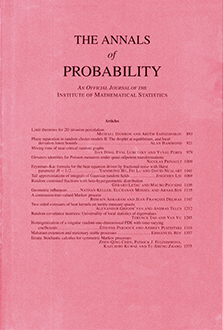Abstract
We study the Glauber dynamics for the $(2+1)\mathrm{D}$ Solid-On-Solid model above a hard wall and below a far away ceiling, on an $L\times L$ box of $\mathbb{Z}^{2}$ with zero boundary conditions, at large inverse-temperature $\beta$. It was shown by Bricmont, El Mellouki and Fröhlich [J. Stat. Phys. 42 (1986) 743–798] that the floor constraint induces an entropic repulsion effect which lifts the surface to an average height $H\asymp(1/\beta)\log L$. As an essential step in understanding the effect of entropic repulsion on the Glauber dynamics we determine the equilibrium height $H$ to within an additive constant: $H=(1/4\beta)\log L+O(1)$. We then show that starting from zero initial conditions the surface rises to its final height $H$ through a sequence of metastable transitions between consecutive levels. The time for a transition from height $h=aH$, $a\in(0,1)$, to height $h+1$ is roughly $\exp(cL^{a})$ for some constant $c>0$. In particular, the mixing time of the dynamics is exponentially large in $L$, that is, $T_{\mathrm{MIX}}\geq e^{cL}$. We also provide the matching upper bound $T_{\mathrm{MIX}}\leq e^{c'L}$, requiring a challenging analysis of the statistics of height contours at low temperature and new coupling ideas and techniques. Finally, to emphasize the role of entropic repulsion we show that without a floor constraint at height zero the mixing time is no longer exponentially large in $L$.
Citation
Pietro Caputo. Eyal Lubetzky. Fabio Martinelli. Allan Sly. Fabio Lucio Toninelli. "Dynamics of $(2+1)$-dimensional SOS surfaces above a wall: Slow mixing induced by entropic repulsion." Ann. Probab. 42 (4) 1516 - 1589, July 2014. https://doi.org/10.1214/13-AOP836
Information





